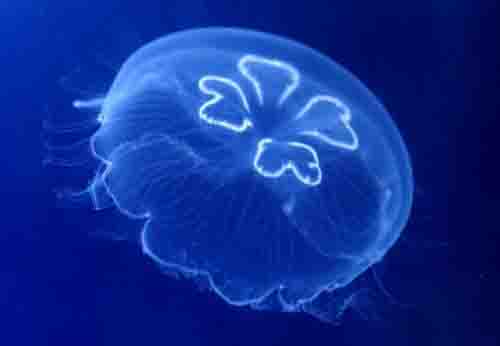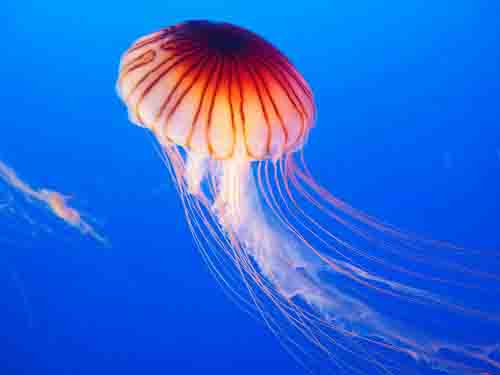Modern society has a lot of anxiety and worries, and it is difficult to live in a stressful society. For a change of pace, I go to the aquarium and look at the fluffy jellyfish, which soothes my soul. The slow movements of jellyfish have been scientifically proven to have a healing effect. Jellyfish float gently in the water, calming the hearts of those who watch them. This movement has the effect of making the parasympathetic nervous system dominant and reducing stress. Jellyfish are creatures without brains and do not think, but they have all the functions needed to survive. Its mysterious ecology also attracts people’s interest and curiosity. There are over 3,000 species of jellyfish in the world, and they come in a variety of shapes and colors. When you look at jellyfish, you can experience the wonder and beauty of nature.
Moon jelly Aurelia aurita

Moon jelly are the most familiar jellyfish in Japan and live all over Japan. Although it looks translucent and weak, it can live in temperatures from -6°C to 30°C, so it is distributed all over the world. The clover-like pattern in the middle of a jellyfish’s cap is its stomach, which is surrounded by horseshoe-shaped gonads. By the way, most of the stomach parts have four, but some have three or even five.
Moon jelly sea nettle by opening and closing its fluffy umbrella is a predatory activity.By opening and closing the umbrella, seawater is filtered between the tentacles, and the zooplankton floating there is captured by the tentacles. Opening and closing an umbrella is also an exercise to activate the circulatory function, and the body itself plays the role of the heart
Japanese sea nettle Chrysaora Pacifica

The Japanese sea nettles look elegant with their thread-like, bright red tentacles. This red jellyfish can also be seen all over the coast of Japan, but its beauty makes it dangerous to touch it. The Japanese sea nettle’s poisonous stinger is very strong and can be very painful. When the Japanese sea nettle is floating in the sea, it can have long tentacles that are over 2 meters long. The red tentacles that flutter each time the umbrella is opened and closed are delicate and beautiful, making it a sight to behold.
Golden medusa (Papuan jelly) Mestigias papua

Golden medusa (Papuan jelly) looks like an octopus. This jellyfish has eight arms under its umbrella, and elongated rod-shaped appendages extend from the tips of the arms, which look like the legs of an octopus.It is brown because zooxanthellae live symbiotically within its body. Zooxanthellae carry out photosynthesis within the jellyfish’s body, and the jellyfish have an unusual lifestyle in which some of the products are used by the jellyfish.Seeing fluffy jellyfish at an aquarium or watching them on YouTube will soothe your soul.
。

![[商品価格に関しましては、リンクが作成された時点と現時点で情報が変更されている場合がございます。] [商品価格に関しましては、リンクが作成された時点と現時点で情報が変更されている場合がございます。]](https://hbb.afl.rakuten.co.jp/hgb/35c24b14.422baeb9.35c24b15.08788b83/?me_id=1356225&item_id=10003370&pc=https%3A%2F%2Fthumbnail.image.rakuten.co.jp%2F%400_mall%2Fkinariglass%2Fcabinet%2Fitem01%2Fcha-kurage01-mask.jpg%3F_ex%3D240x240&s=240x240&t=picttext)




